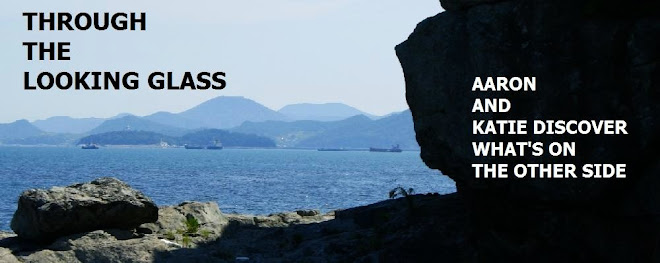
On Friday Katie and I took a bus to Jinju, a city to the northwest of Changwon. Each year a lantern festival is held in Jinju. Large, elaborate lanterns are assembled and floated on the Nam River, and at night they are lit. Katie and I had vague notions of staying the night, but upon arrival found that all the hotels were either booked or asking an inordinate amount for a single night. So, we stowed our backpack at the local E-Mart (they have lockers there) and headed toward the river. The wooden carving above was one of several dozen than lined one of the sidewalks near Jinju Fortress. We are pretty sure they were inspired by traditional Korean folk-religion, which is very shamanistic.

The central cultural attraction of the city is Jinju Fortress (known as 진주성 locally). This is a photo of the main north gate. The fortress holds a special place in the hearts of Koreans as it was the scene of the "Siege of Jinju" in 1592. After easily capturing the fortress at Changwon, the Japanese attacked Jinju Fortress, where 3,800 Korean soldiers were waiting. The Koreans were led by general Kim Si Min, and were vastly outnumbered by the Japanese force of 20,000. Amazingly, after three days the Japanese were forced to retreat, as they had taken heavy losses while unsuccessfully attempting to scale the fortress walls. The victory is fondly remembered by Koreans today. Of course, in 1593, the Japanese returned to Jinju and annihilated the Koreans...

This is another photo of the north gate, this time from inside the fortress.

The city of Jinju from inside the fortress. Our Insight Guide: Korea describes Jinju as "one of Korea's most enchanting and least-visited small cities."

This is Ju Non Gae, a kisaeng (the Korean equivalent of a geisha). After the Japanese conquered the fortress, some of the officers held a celebration. Non Gae and other kisaeng were brought in to entertain them. Non Gae, whose lover had been killed in the battle, lured a Japanese general named Keyamura Rokusuke, near the edge of a cliff above the Nam River. At the cliff's edge she fained love for him and clasped him in an embrace -before dragging him backward with her and leaping off the edge. In honor of Nam Gae's patriotic suicide, a shrine has been built for her at the spot from which she jumped.

A number of stone monuments from the Joseon Period (1392-1910) have been gathered and placed inside the Jinju Fortress. Notice that these monuments are inscribed with Chinese, not Korean characters. The Korean alphabet was invented in the 15th century. Prior to that time, Koreans used only Chinese characters.


Much of the original wall that surrounded the fortress remains intact. Other sections have been carefully and accurately restored.

An elaborate temple stands within the fortress and is surrounded by a wall of its own.


Many of the Buddhist temples we've seen feature swastika motifs. To western eyes, the swastika's association with Hitler and the holocaust is tough to shake. But in Buddhism the swastika is meant to represent harmony. You may also notice that this swastika, unlike the version used by the Third Reich, is facing left. Ironically, a left-facing swastika is meant to represent love and mercy.

The fortress overlooks the Nam River, and from this vantage point we were able to catch our first glimpse of the giant, floating lanterns.

The lanterns are in all shapes and sizes. From a distance they appear to be traditional paper and wood lanterns. However, they are actually made of an elastic nylon-like material stretched over wire frames.



The inspiration for the individual lanterns is not entirely Asian...

...in some cases the lanterns take on very familiar shapes.

The fortress also houses a small museum which contains Japanese and Korean artifacts from the late 16th century.


These elevated pavilions served as a means of issuing orders to soldiers stationed between the inner and outer walls of the fortress. This one, called Bukjangdae, was destroyed between 1592-98 during the Japanese invasions. It was rebuilt in 1618.

I took this photo at another raised pavilion on the opposite side of the fortress. For some reason people were taking their shoes off and placing them on the steps before entering.


Here's a random cute kiddo we spotted near the river. No one stares at us here more than kids, and while they are occasionally terrified, they normally smile and are curious. Parents often urge their kids use their English to say "hi" to us.

A floating foot bridge had been constructed to ease crossing the river. Passage was 1,000 (about $1), and I'm sure they made a killing.


When night came, the lanterns were lit. They were really beautiful; Katie and I had never seen anything like it. Toward evening thousands of people converged upon Jinju in order to see the lanterns. Unfortunately, the tremendous crowds prevented me from getting better (or closer) photos than these.


Tents lined both sides of the river, and contained vendors selling everything from confections and food to socks and rugs. These tents were further down river from the lanterns, but you can get a small impression of what the crowds were like from the photo.

As Katie and I prepared to head back to the bus terminal, we caught an unexpected fireworks display. Overall, we were really impressed with Jinju and the lantern festival.



No comments:
Post a Comment